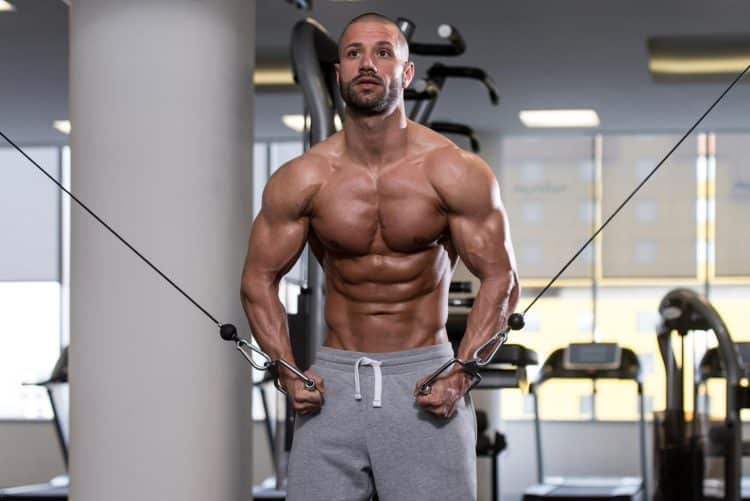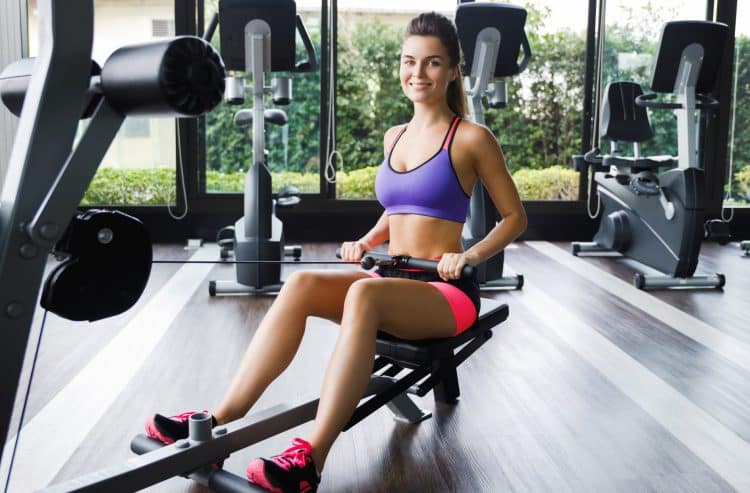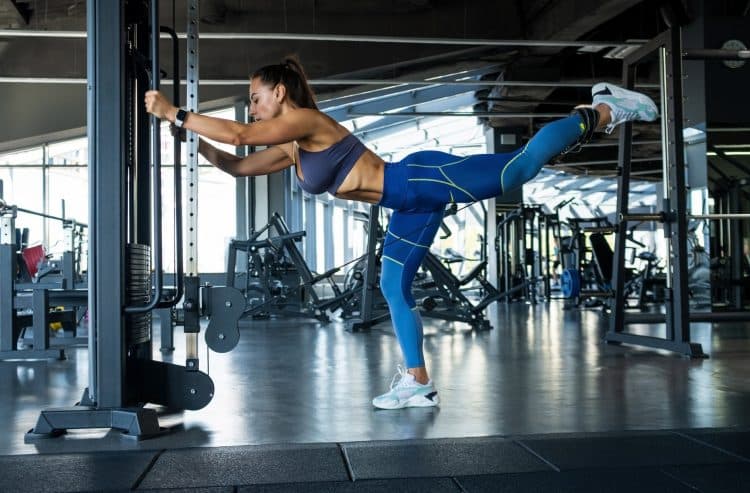Cables are a great training tool to build muscle mass and strength and are a staple in most training regimens. They are great for inducing muscle pumps and can help quicken up your workouts.
Cable exercises are more effective than free-weight exercises in multiple ways. They keep constant tension on your muscles throughout the range of motion, provide a wide range of exercise options, and are safer than free-weight exercises. Plus, the resistance on cable machines is quickly and easily adjustable.
You could program cable exercises into your workouts depending on your goals. Stay in the 8-12 rep range to build muscle mass, and stick to the 1-5 rep range to build explosive power. Furthermore, you can use cable exercises to warm up your muscles at the beginning of a workout or in your cooldown routine.
This article is the ultimate database for cable exercises. Our best cable exercises list is categorized by muscle groups and provides targeted options for a comprehensive workout. We have also included how to perform each exercise with the correct form for optimal results, how to program cable exercises and a full-body cable workout.
Best Cable Exercises For Each Muscle Group
Here are the best cable exercises for each muscle group:
Biceps

We are starting with biceps because who doesn’t like training biceps using cables? Follow a full range of motion while performing these lifts to achieve a muscle-ripping pump. Pause at the static contraction points at the top and bottom to increase your time under tension.
1. Cable Biceps Curl
The cable biceps curl is the most popular cable exercise for building bigger guns. You could use different handle attachments to train your bis from varying angles. Keep your reps slow and controlled to get the most out of this exercise.
Steps:
- Set the pulley attachment at its lowest setting.
- Attach a straight handle to the pulley.
- Face the pulley and grab the bar with a supinated (underhand) grip.
- Take a step back. The cable should be taut at the starting position.
- Stand upright with a shoulder-wide stance.
- Brace your core, contract your glutes, and lift the bar toward your shoulders by bending your elbows.
- Pause and contract your pythons at the top.
- Slowly return to the starting position.
- Repeat for recommended reps.
[sc name=”style-summary-2nd” ]
Pro Tip: Keep your elbows pinned and avoid using momentum by swinging back and forth to achieve an optimal muscle pump.
[/sc]
Benefits of Cable Biceps Curl
- Helps maintain constant tension on your bis throughout the range of motion.
- Different bar attachments, such as an EZ bar, can make the move more effective by reducing stress on your wrists.
- It better isolates the target muscle and helps you focus on the biceps peaks.
Check out our complete cable curl guide here!
2. Dual Cable Biceps Curl
Many lifters find the cable biceps curl uncomfortable because of the stress it places on their wrists. The dual cable biceps curl solves this problem. It is a unilateral exercise that allows you to train one side of your body at a time, helping you fix muscle and strength imbalances.
The dual cable biceps curl is performed on a functional trainer, separate from the cable crossover machine. The cable pulleys of the functional trainer are closer than the conventional cable machine, allowing you to perform this biceps exercise. The 2021 Arnold Classic champ Nick Walker swears by the dual cable biceps curl, and given that he has some of the best pythons in the business, it is safe to say this exercise delivers!
Steps:
- Adjust both pulleys of the functional trainer at their lowest setting and hook up D-handle attachments on both ends.
- Stand between the pulleys while facing away.
- Grab the handles with a supine grip and step forward. Assume a shoulder-wide staggered stance for better stability.
- Your elbows will be behind your body throughout the exercise.
- While keeping your elbows pinned, curl the cables to your chest level.
- Pause and contract your guns at the top.
- Slowly return to the start position.
- Repeat for reps.
[sc name=”style-summary2″ ]
Pro Tip: Perform a few unilateral reps after hitting failure on the bilateral reps. Doing this will leave you with a muscle-ripping pump.
[/sc]
Benefits of Dual Cable Biceps Curl
- A unilateral exercise that can help fix muscle and strength imbalances.
- It allows you to work through a larger range of motion.
- A wrist-friendly biceps movement.
3. High Cable Curl
High cable curl is one of the best exercises to work on your biceps peak and perfect your front double biceps pose. Most lifters perform this exercise at the end of the training routine to annihilate their pythons.
Many lifters leave gains on the table while performing high cable curls by using more weights than they can handle. You must keep your shoulder pulled back and elbows pinned for optimal biceps stimulation.
Steps:
- Set the cable pulleys at head height and fix D-handle bars on each side.
- Stand in the middle of the cable pulley with a shoulder-wide stance.
- Grab the handles with a supine (palms facing upward) grip.
- Bend your elbows slightly and maintain your natural spine arc. Hold this position throughout the exercise.
- Keep your elbows pinned and curl the handle so your hands are next to your ears.
- Pause and contract at the top.
- Slowly return to the start position.
[sc name=”style-summary-2nd” ]
Pro Tip: Take half a step forward, so your elbows are pulled back. It will push out your chest and help better isolate your pythons.
[/sc]
Benefits of High Cable Curl
- One of the best exercises to work on your biceps peaks.
- It can help improve your posture.
Check out our complete high cable curl guide here!
[sc name=”style-summary-2nd” ]
Find more cable biceps exercises here.
[/sc]
Triceps

The triceps are engaged in all pushing activities. Using isolation exercises to train your tris can ensure overall development. You must perform a range of triceps exercises in your training regimen to engage all three triceps heads — medial, lateral, and long.
4. Cable Triceps Pressdown
The cable triceps press-down works the medial and lateral triceps heads. Many lifters make the mistake of leaning over the bar too much while performing the exercise. It removes tension from your triceps and puts it on your shoulders.
Steps:
- Set a cable pulley at the highest setting.
- Attach a straight bar to the pulley and grab it with an overhand grip.
- Step back and pull down the cable so your elbows are at your sides, and the bar is at your shoulder level.
- Lean forward slightly and hold this position for the duration of the set.
- While keeping your elbows pinned, press down the bar.
- Do not lock your elbows at the bottom to maintain constant tension on your tris.
- Return to the start position and repeat for reps.
[sc name=”style-summary-2nd” ]
Pro Tip: Your lower arms should be under your shoulders at the bottom. Keeping your elbows behind your shoulders will result in the bar bumping into your quads.
[/sc]
Benefits of Cable Triceps Pressdown
- One of the best exercises to build explosive triceps strength.
- Keeps constant tension on your triceps throughout the range of motion.
- It can help develop defined horseshoe triceps.
Check out our complete cable triceps pressdown guide here!
5. Cable Overhead Triceps Extension
The cable overhead triceps extension works the long and medial triceps heads. It is the more stubborn part of the triceps that demands training intensity, volume, and frequency. Focus on contracting your muscles at the top for optimal muscle engagement.
Steps:
- Set the cable pulley at the lowest setting and connect a rope attachment.
- Grab the ropes with a neutral (palms facing inward) grip.
- Pull the rope overhead while simultaneously turning away from the pulley. Your back should be toward the pulley.
- Assume a shoulder-wide stance.
- Your upper arms should be perpendicular to the floor throughout the exercise.
- Brace your core, contract your glutes, and extend your arms, so your hands are above your head at the movement’s top.
- Pause and contract your muscles.
- Slowly return to the start position.
[sc name=”style-summary-2nd” ]
Pro Tip: Keep your upper arms as close to your ears as possible. Flaring your elbows will remove tension from your triceps and put it on your shoulders.
[/sc]
Benefits of Cable Overhead Triceps Extension
- An incredibly effective exercise to work your long triceps head.
- This is a low-impact exercise that doesn’t overexert your elbows.
Check out our complete cable overhead triceps extension guide here!
6. Cable Triceps Kickback
Kickbacks primarily work your lateral triceps head. The problem with dumbbell kickbacks is that your triceps are not under tension for most of the movement. Using a cable fixes this issue, and you’ll feel stress on your triceps throughout the ROM.
Steps:
- Set the cable pulley at waist height.
- Grab the cable and step back. The weights should be engaged at the bottom of the movement.
- Bend forward by hinging at your hips. Your torso should be parallel to the floor.
- Maintain a slight bend in your knees.
- Your upper arm should be in line with your torso.
- Extend your arm straight while keeping your elbow pinned to your side.
- Pause and contract at the top.
- Slowly return to the start position.
- Repeat for recommended reps.
[sc name=”style-summary-2nd” ]
Pro Tip: Do not use any attachments for this exercise. Grabbing the bar puts your wrist in a neutral position, which helps isolate the triceps better.
[/sc]
Benefits of Cable Triceps Kickback
- Using a cable on the triceps kickback keeps constant tension on the target muscle.
- Using a dumbbell in this exercise engages your shoulder and back because gravity pulls down the weight. The cable machine negates this issue.
Check out our complete cable triceps kickback guide here!
[sc name=”style-summary-2nd” ]
Find more cable triceps exercises here.
[/sc]
Chest

Many lifters use cable exercises to end their chest workouts with a muscle-ripping pump. Furthermore, you could use cable exercises at the beginning of your training sessions to pre-exhaust your pecs, so you don’t have to lift as heavy on compound movements like the bench press.
7. Cable Crossover
The cable crossover is a staple in most chest training regimens. Many people confuse the cable crossover with the iron crossover. As the name suggests, the cable crossover requires you to crossover your hands at the bottom of the movement. On the other hand, your fists are touching each other at the bottom of the iron cross.
Steps:
- Set the cable pulleys at their highest setting and hook up D-handle bars.
- Grab the handles with an overhand grip.
- Take a step forward and assume a staggered stance.
- Lean forward slightly and push out your chest.
- Your arms should be extended at your sides at the starting position.
- While maintaining a slight bend in your elbows, bring your arms in front of your body.
- Crossover your hands at the bottom and squeeze your pecs with all your might.
- Slowly return to the start position.
- Repeat for recommended reps.
[sc name=”style-summary-2nd” ]
Pro Tip: Imagine hugging a tree while performing this exercise. Limit the movement to your shoulder joints.
[/sc]
Benefits of Cable Crossover
- The cable crossover is an incredibly effective exercise to develop your inner pecs.
- It can help improve chest conditioning and striations.
Check out our complete cable crossover guide here!
8. Cable Chest Press
The cable chest press is excellent when you can’t get your hands on dumbbells or a bench during rush hours. This exercise will also help build your core strength and stability.
Steps:
- Set cable pulleys at chest height and attach D-handle bars.
- Stand between the pulley with a shoulder-wide stance.
- Grab the handles with pronated (palms facing down) grips.
- Take a step forward and assume a staggered stance.
- Your hands should be at the side of your chest at the starting position.
- Press the handles in front of your body while keeping your arms parallel to the floor.
- Your thumbs should touch each other at the movement’s top.
- Pause and contract.
- Return to the start position and repeat for recommended reps.
[sc name=”style-summary-2nd” ]
Pro Tip: Keep your neck neutral. Dropping your head back or tucking in your chin puts unnecessary stress on your neck.
[/sc]
Benefits of Cable Chest Press
- An effective dumbbell bench press alternative.
- Helps achieve a muscle-ripping pump.
- It puts less strain on your joints than the dumbbell bench press.
Check out our complete cable chest press guide here!
[sc name=”style-summary-2nd” ]
Find more cable chest exercises here.
[/sc]
Back

Contrary to what most lifters think, you can build a toned and defined back using cable exercises. Cable back exercises are especially great for people dealing with injuries.
9. Straight Arm Lat Pulldown
This lat pulldown variation can help build a wide and dense back. You might experience considerable triceps involvement while going heavy on this exercise. Use different handlebar attachments to target your back from different angles.
Steps:
- Set the cable pulley at the highest setting and hook a straight handlebar attachment.
- Grab the bar with a shoulder-wide overhand grip and step back.
- While maintaining a slight bend in your knees, push your hips back and lower your torso toward the floor until it is at a 45-degree angle.
- Keeping your elbows slightly flexed, pull the bar to your thigh until the lats are fully contracted.
- Pause and contract your lats at the bottom.
- Return to the start position.
[sc name=”style-summary-2nd” ]
Pro Tip: Keeping your core braced throughout the exercise will improve your stability. Avoid using momentum by swinging your torso up and down.
[/sc]
Benefits of Straight Arm Lat Pulldown
- A great exercise to engage your lats without engaging your biceps.
- The bent-over position helps you stimulate your lats better.
Check out our complete cable straight arm lat pulldown guide here!
10. Kneeling Isolateral Cable Pull-Down
The kneeling isolateral cable pull-down is an underutilized back exercise that helps build a wider back without requiring you to use heavy weights.
Steps:
- Set the cable pulley at the highest setting and attach D-handle bars.
- Grab the handles with a neutral (palms facing forward) grip and kneel in the center of the cable pulleys.
- Pull your elbows to your sides while maintaining an upright torso.
- Pause and contract at the bottom.
- Return to the starting position.
- Repeat for reps.
[sc name=”style-summary-2nd” ]
Pro Tip: The lat contraction at the bottom is the most important part of the lift. Bring your elbows into your sides and contract your lats as hard as possible.
[/sc]
Benefits of Kneeling Isolateral Cable Pull-Down
- Works your lats through their full range of motion, allowing optimal muscle fiber stimulation.
- It is a low-risk exercise, as you don’t have to lift super heavy.
11. Seated Cable Row
The cable row is a popular back exercise that helps build thickness and definition. You could do it on a standalone cable row machine or the cable machine pulley. We’ll use the latter for this example.
Steps:
- Set the cable pulley to its lowest setting and attach a V-handle bar.
- Set an aerobic step at the bottom of the pulley to increase the range of motion.
- Sit on the floor and place your feet against the aerobic step.
- Grab the handles with a neutral (palms facing each other) grip.
- While maintaining an upright torso, bring the bar to your belly button by driving through your elbows.
- Pause and contract your lats at the top.
- Slowly return to the start position.
- Repeat for reps.
[sc name=”style-summary-2nd” ]
Pro Tip: Pulling though your arms will result in greater biceps engagement. Focus on pulling through your elbows for optimal lat engagement. Use your hands as hooks.
[/sc]
Benefits of Seated Cable Row
- One of the best exercises to build back thickness.
- Allows you to contract your muscles throughout the range of motion.
Check out our complete seated cable row guide here!
[sc name=”style-summary-2nd” ]
Find more cable back exercises here.
[/sc]
Shoulders

Free-weight shoulder exercises can help you build shoulder strength and muscle mass. However, you need cable exercises for overall development and building 3D shoulders.
12. Cable Lateral Raise
The one-arm cable lateral raise is an effective shoulder unilateral exercise to help fix muscle and strength imbalances. It helps achieve constant muscle contraction throughout the range of motion, leaving you with a sick pump.
Steps:
- Set the cable pulley at the lowest setting and attach a D-handle bar attachment.
- Stand with your left side toward the pulley.
- Grab the handle with your right hand using a neutral (palms facing the pulley) grip. Hold onto the pulley with your left hand for support.
- The handle should be in front of your left thigh at the start position.
- Stand with your feet placed together and slightly lean toward your right side.
- While maintaining a slight bend in your elbow, raise your arm to your side until it is parallel to the floor.
- Pause and contract at the top.
- Slowly return to the start position.
[sc name=”style-summary-2nd” ]
Pro Tip: Lower the bar to the start position using a slow and deliberate motion for optimal shoulder muscle fiber engagement.
[/sc]
Benefits of Cable Lateral Raise
- Helps isolate the middle shoulder head.
- A low-impact exercise that doesn’t overexert your elbow or shoulder joints or rotator cuffs.
Check out our complete cable lateral raise guide here!
13. Cable Front Raise
The dumbbell front raise can help build bigger and stronger anterior delts but using free weights doesn’t maintain constant tension on your shoulder joints throughout their range of motion. The cable front raise fixes this issue.
Steps:
- Set the cable pulley at the lowest setting and hook up a straight bar attachment.
- Stand over the bar with your back toward the pulley.
- Grab the bar with a shoulder-wide overhand grip and step forward.
- Lean forward slightly for optimal anterior delt engagement.
- While maintaining a slight bend in your elbows, raise your arms in front of you until they are parallel to the floor.
- Pause and contract.
- Return to the start position.
[sc name=”style-summary-2nd” ]
Pro Tip: Using a rope attachment can help train your delts from a different angle because of the neutral grip.
[/sc]
Benefits of Cable Front Raise
- A great exercise to isolate your front delts.
- The movement pattern keeps constant tension on your shoulders throughout the range of motion.
Check out our complete cable front raise guide here!
14. Cable Rear Delt Fly
The rear delts are one of the most stubborn muscle groups; they are also a lagging muscle for most lifters. The cable does a great job of isolating this small muscle.
Steps:
- Set the pulleys at the highest setting.
- Grab the left cable with your right hand and vice versa.
- Walk to the cable pulley’s center and step back. Your hands should be in front of your chest, and the cables should be taut at the starting position.
- Stand upright with a shoulder-wide stance.
- While maintaining a slight bend in your elbows, bring your arms to your sides.
- Pause and contract your rear delts at the top.
- Slowly return to the starting position.
- Repeat for reps.
[sc name=”style-summary-2nd” ]
Pro Tip: Avoid arching your back at the movement’s top, as doing so removes the tension from your posterior delts and puts it on your upper back.
[/sc]
Benefits of Cable Rear Delt Fly
- This exercise is incredibly effective in isolating your posterior deltoids.
- You don’t have to go super heavy to engage the target muscles.
[sc name=”style-summary-2nd” ]
Find more cable shoulder exercises here.
[/sc]
Legs

Adding a couple of cable exercises to your leg training regimen can be beneficial in improving your lower body conditioning. Cable leg exercises are a great fit for people dealing with injuries.
15. Cable Squat
This squat variation is great for people with injuries as it doesn’t put their lower back under much stress. It also forces you to use a strict form.
Steps:
- Set the cable pulley at the lower setting and hook up a V-handle attachment.
- Stand next to the V-handle attachment with a shoulder-wide stance.
- Squat down and grab the V-handle bar with an underhand (palms facing the ceiling) grip.
- Hold the bar beside your chest while maintaining an upright torso.
- Extend your knees to stand upright.
- Lower into a deep squat while pushing your hips back and down while maintaining a straight back.
- Pause at the bottom.
- Explode back to the start position.
- Repeat for recommended reps.
[sc name=”style-summary-2nd” ]
Pro Tip: Place a 45-pound weight plate under your heels if you have trouble maintaining an upright torso while squatting.
[/sc]
Benefits of Cable Squat
- It allows you to use additional resistance without stressing your lower back.
- The cable squat is easy to set up, and you can get done with your recommended sets and reps on this exercise faster than the barbell squat.
Check out our complete cable squat guide here!
16. Cable Glute Kickback
The glutes are our body’s biggest and strongest muscle group, and the cable glute kickback helps isolate your butt. You should regularly train them to ensure optimal strength and muscle gains.
Steps:
- Set the cable pulley at the lowest setting and install an ankle wrap attachment.
- Hook up the ankle wrap around your right ankle while facing the pulley. Grab onto the pulley for stability.
- Bend forward slightly for optimal glute isolation.
- Keeping your left foot on the floor, raise your right leg toward the ceiling while maintaining a slight knee bend.
- Pause and contract at the top.
- Slowly return to the start position.
- Repeat for recommended reps before switching sides.
[sc name=”style-summary-2nd” ]
Pro Tip: Keep your reps slow and controlled. Using momentum to raise your legs will result in the hamstring and lower back engagement.
[/sc]
Benefits of Cable Glute Kickback
- This exercise is great for improving your lower body aesthetics and getting rid of the pancake ass.
- Works your glutes without overloading your lower back.
17. Standing Cable Calf Raise
Cables are underutilized in calf training regimens. They can help keep constant tension on your calves throughout the range of motion. We recommend using a dip belt for the cable calf raise for optimal results.
Steps:
- Adjust the cable pulley at the lowest setting and hook up a dip belt to the pulley.
- Set an aerobic step at the base of the pulley.
- Place the balls of your feet on the edge of the aerobic step.
- Wear the dip belt. Ensure that the weight doesn’t touch the stack at the bottom of the movement.
- While maintaining a slight bend in your knees, raise your heels as high as possible.
- Pause and contract your calves at the top.
- Slowly return to the start position and repeat for reps.
[sc name=”style-summary-2nd” ]
Pro Tip: You could use a 45-pound weight plate if you don’t have access to an aerobic step.
[/sc]
Benefits of Standing Cable Calf Raise
- It helps isolate the gastrocnemius muscle.
- Performing this exercise doesn’t overload your spine.
18. Cable Crunch
The cable crunch is an incredibly effective exercise for working your abdominals. It keeps constant tension on your abs throughout the range of motion, which is optimal for building a six-pack.
Steps:
- Adjust the cable pulley at the height setting and hook up a rope attachment.
- Grab the ropes with a neutral (palms facing each other) grip and step back.
- Kneel on the floor and place your hands on your shoulders. The rope anchor should be behind your head.
- Brace your core, contract your glutes, and perform a crunch.
- Your upper legs should be perpendicular to the floor throughout the range of motion, and your elbows should touch the top of your knees at the bottom.
- Pause and contract your abs.
- Slowly return to the start position and repeat for reps.
[sc name=”style-summary-2nd” ]
Pro Tip: Breathe out during the lift’s concentric (lowering) portion and inhale during the eccentric (upward) motion.
[/sc]
Benefits of Cable Crunch
- Keeps constant tension on your abs throughout the range of motion.
- Works your abs through their full range of motion.
Check out our complete cable crunch guide here!
Benefits of Adding Cables To Your Workouts
Here are the advantages of adding cables to your training regimen:
Versatility
Cables are the most versatile training equipment in the gym. You can use them for training each muscle group, and people of different shapes and sizes can adjust them to train their target muscles optimally.
Easy To Change Resistance
Changing weights on a barbell can be challenging, especially while going heavy. Furthermore, although you don’t need to change the weight plates on dumbbells, racking, and unracking dumbbells can be a hassle. The cable machine solves this problem. It comes with a pin to adjust the weights according to your needs.
Low-Impact
The cable machine allows for a smooth and controlled range of motion, making it easier on your joints than free weights. Additionally, it is safer than free weights. You hardly hear about people injuring themselves on the cable machine.
Constant Tension on Your Muscles
Using a cable machine keeps constant tension on your target muscles throughout the range of motion. You must use a vertical range of motion while using free weights to stimulate your muscle groups, whereas cables allow you to work through every imaginable movement plane.
Programming Cable Exercises Into Your Workouts
You can use cable exercises in your strength and hypertrophy workouts. Furthermore, you could use them in your warm-up and cooldown routines. Use these tips to master cable use in your training regimen:
- Hypertrophy: Stay in the 8-12 rep range if your primary goal is to build muscle mass. You can perform cable exercises at any point during your workout. Using them before a workout allows you to pre-exhaust your muscles, whereas doing cable exercises at the end leaves you with a muscle-ripping pump. [1]
- Strength: Stay in the 1-5 rep range on the cables to build explosive strength. Plus, you should use cables in your accessory training routine to strengthen your three big lifts — squat, bench press, and deadlift.
- Rehabilitation: Folks dealing with injuries should stick to cable training during recovery. You must consult your doctor before training with an injury.
Sample Full-Body Cable Workout
Below is a sample full-body cable workout using the resistance exercises listed in this article:
| Exercises | Sets | Reps |
| Cable Crossover | 3 | 8-12 |
| Straight Arm Lat Pulldown | 3 | 8-12 |
| Cable Lateral Raise | 3 | 8-12 |
| Cable Biceps Curl | 3 | 8-12 |
| Cable Triceps Kickback | 3 | 8-12 |
| Cable Squat | 3 | 8-12 |
Wrapping Up
Cable exercises allow you to focus on a specific muscle group, allowing you to fix lagging muscle groups and build a well-rounded physique. Thanks to their versatility, you can add them to any training program.
Use this article as the database for the most effective cable exercises for each muscle group or combine exercises for each muscle group for an effective full-body workout. Best of luck!
References
- Krzysztofik M, Wilk M, Wojdała G, Gołaś A. Maximizing Muscle Hypertrophy: A Systematic Review of Advanced Resistance Training Techniques and Methods. Int J Environ Res Public Health. 2019 Dec 4;16(24):4897. doi: 10.3390/ijerph16244897. PMID: 31817252; PMCID: PMC6950543.


